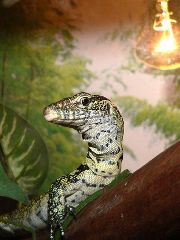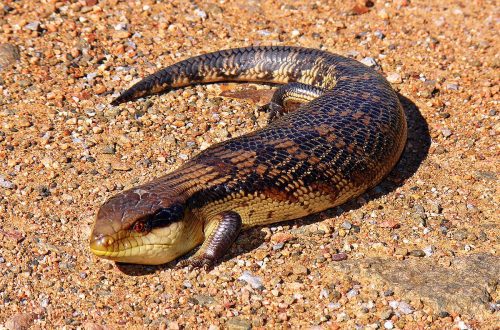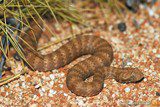
Deadly snake
There are three subspecies of death snakes: viper death snake, New Guinea death snake and fire death snake. Each of the subspecies lives in a separate part of the range. The viper snake can be found in New Guinea, throughout Australia and sometimes on offshore islands, but it is not found in the coldest parts of the south-east of Australia and in the central deserts. Most of all, this snake prefers the sparsely populated bush, especially the hills overgrown with grass. In New Guinea, it can be found in the rain forests, and sometimes on coffee plantations. Basically, the deadly snake leads a terrestrial lifestyle. The peak of its activity falls at night.
Contents
Classification
 Kingdom: Animals
Kingdom: Animals
Type: Chord
Subtype: Vertebrates
Class: Reptiles
Order: Scaly
Suborder: Snakes
Family: Asps
Genus: Deadly snakes.
Inhabitation
 The deadly snake leads a terrestrial lifestyle. The peak of activity of all these subspecies is mainly nocturnal. Representatives of the deadly snake are very secretive – during the daytime, they spend most of their time either resting or waiting for prey in ambush.
The deadly snake leads a terrestrial lifestyle. The peak of activity of all these subspecies is mainly nocturnal. Representatives of the deadly snake are very secretive – during the daytime, they spend most of their time either resting or waiting for prey in ambush.
In each separate part of the range, only one of the types of deadly snakes lives. Acanthophis antarcticus can be found almost everywhere in Australia, it is found on the coastal islands, but is not found in the central deserts and in the coldest parts of the southeast of Australia (Victoria, part of New South Wales, Tasmania). It is also distributed in Papua New Guinea.
Acanthophis praelongus is found in New Guinea and tropical northern Australia.
Acanthophis pyrrhus has been restricted to dry parts of Australia: Western Australia, southern Northern Territory and northern South Australia.
The favorite habitat of the deadly snake is the sparsely populated bush, especially the hills overgrown with cereals. In New Guinea, it is most often found in monsoon and rain forests, sometimes even on coffee plantations.
During the day, they either rest or lie in wait for prey.
This snake is one of the most venomous snakes on the planet. Unlike most of her kind, she does not take a frightening pose in moments of danger. Moreover, it will remain motionless, relying on its coloration, or, if it is in an open area at that moment, it will simply crawl away.
This snake has a very wide head for a triangular asp with a pronounced cervical interception and vertical pupils. Her body is thick and curvy, on average it reaches from 50 to 90 cm in length. Males are inferior in size to females. The tail of a deadly snake is strongly narrowed and ends in a modified shield in the form of a horn shield. The color varies from brown to gray, which depends, among other things, on the color of the vegetation and soil in the snake’s habitat. Its back is covered with transverse irregular black stripes. Below the tail is covered with unpaired simple shields.
The venom of a deadly snake is extremely toxic. To kill more than 2200 mice, the venom of just one snake will be enough. It has a neurotoxic effect almost one and a half times more than cobra venom. However, unlike most snakes, the symptoms of poisoning after a bite from this species develop rather slowly, reaching a peak after one to two days after the bite. The diet of this snake consists of amphibians, birds, lizards and small mammals, on which it hunts from ambush, curling up in the shape of a horseshoe.
Description
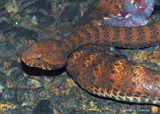 Representatives of this genus of snakes are among the most poisonous snakes on the planet.
Representatives of this genus of snakes are among the most poisonous snakes on the planet.
The deadly snake is very secretive, spending most of the daytime resting or waiting for prey. Peak activity occurs at night. The deadly snake is quite easy prey for predators, as it is slow and clumsy. This is also why the snake prefers to move under the cover of night, and especially when the weather is unstable and a cold atmospheric front is approaching.
Unlike most snakes in Australia, the deadly ones do not assume a fearful posture when approached. On the contrary, it will lie motionless, relying on its protective coloration, or, being in an open area, crawls away. Deadly snakes are widespread enough that they are not among the protected species.
The deadly snake has an unusually wide triangular head for an asp. The body is thick and short, on average 50-90 cm long. Females are slightly larger than males. The tail is strongly narrowed and ends with a horn spike – a modified shield. Color varies from gray to brown. It depends, among other things, on the color of the soil and vegetation in the habitat. The back is covered with irregular transverse black stripes. The end of the tail is often colored black and/or white.
The poison of a deadly snake is extremely toxic. The venom of one snake would be enough to kill over 2200 mice. The venom has an almost exclusively neurotoxic effect and is almost one and a half times stronger than cobra venom. Unlike most Australian asps, the symptoms of poisoning after a bite from a deadly snake develop slowly, reaching a maximum in a day or two after the bite. Due to the deadly snake’s stealth, encounters during the day are quite rare, and most bites occur when it is stepped on.
Food
 The diet of the deadly snake consists of birds, amphibians, small mammals and lizards. She hunts from an ambush, while curling up in the shape of a horseshoe. During the hunt, they hide in the grass and fallen leaves, using their tail as bait, which is slowly and worm-like wriggling. When the victim approaches, the snake rushes at it with such speed that the victim usually does not even have time to touch the wriggling tail.
The diet of the deadly snake consists of birds, amphibians, small mammals and lizards. She hunts from an ambush, while curling up in the shape of a horseshoe. During the hunt, they hide in the grass and fallen leaves, using their tail as bait, which is slowly and worm-like wriggling. When the victim approaches, the snake rushes at it with such speed that the victim usually does not even have time to touch the wriggling tail.
Reproduction
Deadly snakes are viviparous – in a litter, on average, about 8 cubs. Sexually mature age occurs at 2-3 years of age. The first postpartum molt of newborns takes place 10-15 days after birth.
content
The pair is kept mainly separately in terrariums with shelters on a thick layer of large shavings. The optimum temperature is from 22 to 28°C. Humidity also needs to be maintained. This is done by spraying water 2-3 times a week. Food – laboratory mice.
Additionally
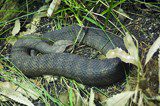 From the Greek, the name of this snake is translated as “prickly snake.”
From the Greek, the name of this snake is translated as “prickly snake.”
A pair of New Guinean deadly snakes appeared in the Moscow Zoo in September 1997.
This species of snake is quite widespread, therefore it is not among the protected species. Despite this, the number of deadly snakes is still declining. Their habitat is being destroyed (grazing and clearing the bush), feral and domestic animals are also making their efforts. Thousands of deadly snakes die every year under the wheels of cars. In Australia, the distribution of the Aga toad has caused severe damage to the population. The fact is that the snakes that feed on this toad die from its poisonous skin glands, from which it has no protection.
The deadly snake first appeared in the Moscow Zoo in September 1997 from Indonesia (New Guinea). The snakes were mostly kept individually, in wooden terrariums with shelters, which were located on a thick layer of large shavings. The temperature of the content ranged from 22 to 28 degrees. Optimum air humidity was maintained by spraying water, this was done 2-3 times a week. The diet of snakes was made up of laboratory mice. During the year, a female was periodically placed with the male, but sexual behavior was not observed either at night or during the day. Previously, the snakes lowered the temperature to 20 degrees. In 2001-2002, after seating with a male, several stillborn cubs were found in the terrarium. Starting in 2003, snakes were given complex mineral and multivitamin supplements along with mice, which led to long-awaited results. In November of that year, one dead and six live cubs were born, and the female laid six fatty eggs. The first postpartum molt in babies occurred on the 10-11th day after birth. After that, most of the cubs began to feed on 2-3 day old mice on their own.
Sources of
http://ru.wikipedia.org
http://www.floranimal.ru
http://www.povodok.ru
http://petland.org.ua
http://www.yadoktor.ru
Subspecies
There are three main types of deadly snakes:
Acanthophis antarcticus or viper-like death snake,
Acanthophis praelongus or New Guinea death snake,
Acanthophis pyrrhus or fiery death snake.




